Core Practical 10: Rate of Photosynthesis (Edexcel International A Level Biology) : Revision Note
Rate of Photosynthesis
For photosynthesis to occur the following are required
The presence of photosynthetic pigments
A supply of carbon dioxide
A supply of water
Light energy
A suitable temperature
If there is a shortage of any of these factors, photosynthesis cannot occur at its maximum possible rate
The main external factors that affect the rate of photosynthesis are
Light intensity and wavelength
Carbon dioxide concentration
Temperature
These are known as limiting factors of photosynthesis
If any one of these factors is below the optimum level for the plant, its rate of photosynthesis will be reduced, even if the other two factors are at the optimum level
Note that although a lack of water can reduce the rate of photosynthesis, water shortages usually affect other processes in the plant before affecting photosynthesis and water is therefore not one of the main limiting factors
Light intensity
The rate of photosynthesis increases as light intensity increases
The greater the light intensity, the more energy supplied to the plant and therefore the faster the light-dependent stage of photosynthesis can occur
This produces more ATP and reduced NADP for the Calvin cycle, which can then also occur at a greater rate
During this stage, light intensity is said to be a limiting factor of photosynthesis
At some point, if light intensity continues to increase, the relationship above will no longer apply and the rate of photosynthesis will reach a plateau
At this point light intensity is no longer a limiting factor of photosynthesis; another factor is limiting the rate
E.g. temperature being too low or too high, or not enough carbon dioxide

Light intensity can be a limiting factor for photosynthesis
Carbon dioxide concentration
The rate of photosynthesis increases as carbon dioxide concentration increases
Carbon dioxide is one of the raw materials required for photosynthesis
It is required for the light-independent stage of photosynthesis; CO2 is combined with the five-carbon compound ribulose bisphosphate (RuBP) during carbon fixation
This means the more carbon dioxide that is present, the faster this step of the Calvin cycle can occur and the faster the overall rate of photosynthesis
This trend will continue until some other factor, e.g. temperature or light intensity, prevents the rate from increasing further

Carbon dioxide concentration can be a limiting factor for photosynthesis
Temperature
As temperature increases the rate of photosynthesis increases up to a point, after which the rate decreases
This is because many of the reactions of photosynthesis are catalysed by enzymes
At low temperatures enzyme-catalysed reactions occur slowly due to a lack of kinetic energy and therefore few collisions between enzyme and substrate molecules
At high temperatures enzymes denature
The Calvin cycle is affected by temperature, e.g. rubisco catalyses the reaction between CO2 and the five-carbon compound ribulose bisphosphate
As long as there is enough light to produce ATP and NADPH in the light-dependent reaction, increasing temperature up to an optimum temperature will increase the rate of the light-independent reactions and therefore the rate of photosynthesis

Temperature can be a limiting factor for photosynthesis
Investigating the rate of photosynthesis
Investigations to determine the effects of light intensity, light wavelength, carbon dioxide concentration, and temperature on the rate of photosynthesis can be carried out using aquatic plants such as Elodea or Cabomba
Aquatic plants are especially useful for investigating the rate of photosynthesis because the waste oxygen gas produced can be easily collected and measured underwater
The effect of these limiting factors on the rate of photosynthesis can be investigated in the following ways
Light intensity
Change the distance of a light source from a plant
Light wavelength
Change a colour filter placed over a light source illuminating a plant
Carbon dioxide concentration
Add different quantities of sodium hydrogencarbonate (NaHCO3) to the water surrounding a plant; this dissolves to produce CO2
Temperature
Place boiling tubes containing submerged plants in water baths of different temperatures
Whilst changing one of these factors during an investigation, ensure that other factors remain constant
E.g. when investigating the effect of light intensity on the rate of photosynthesis, a glass tank should be placed in between the lamp and the boiling tube containing the pondweed to absorb heat from the lamp; this prevents the solution surrounding the plant from changing temperature
Investigating the effect of light intensity on the rate of photosynthesis
Apparatus
Distilled water
Boiling tube
Beaker
Lamp
Aquatic plant, algae or algal beads
Metre ruler
Sodium hydrogen carbonate solution
Thermometer
Boiling tube bung and delivery tube
Measuring syringe
Method
Optional: ensure the water is well aerated before use by bubbling air through it
This will ensure that any oxygen gas given off by the plant during the investigation forms bubbles instead of dissolving
Ensure the plant has been well illuminated before use
This will ensure that the plant contains all the enzymes required for photosynthesis and that any changes of rate are due to changes in light intensity
Set up the apparatus in a darkened room with a 10 cm distance between the lamp and the boiling tube
This means that no external light sources will affect the rate of photosynthesis
Cut the stem of the pondweed cleanly just before placing into the boiling tube
This enables bubbles of oxygen to form from the cut plant stem
Submerge the sample of pondweed in sodium hydrogen carbonate solution
This ensures that the pondweed has a controlled supply of carbon dioxide
Measure the volume of gas collected in the gas syringe over a set period of time, e.g. 1 minute; repeat this measurement e.g. 3 times
Change the independent variable by moving the light source 10 cm further away from the plant and repeat step 6
Repeat step 7 several more times, moving the lamp 10 cm further away from the plant each time
Record the results in a table and plot a graph of volume of oxygen produced per minute against the distance from the lamp

The effect of light intensity on the rate of photosynthesis can be investigated by measuring the volume of oxygen produced as a lamp is moved further away from an aquatic plant
Results
The closer the lamp, the higher the light intensity, therefore the volume of oxygen produced should increase as the light intensity is increased
At a point the volume of oxygen produced will stop increasing even if the light is moved closer
This is the point at which light intensity stops being the limiting factor and, e.g. temperature or concentration of carbon dioxide becomes limiting

You've read 0 of your 5 free revision notes this week
Sign up now. It’s free!
Did this page help you?
